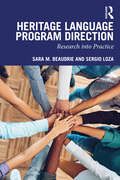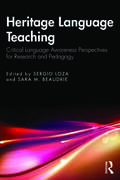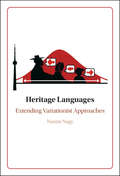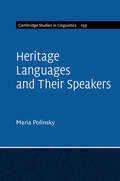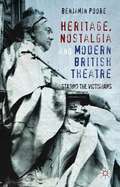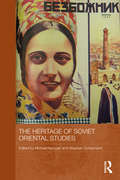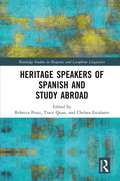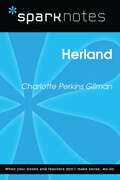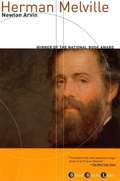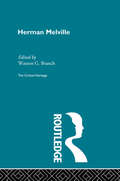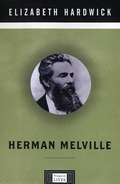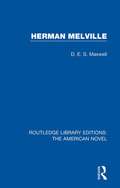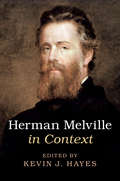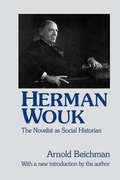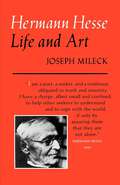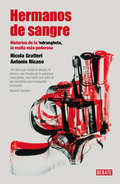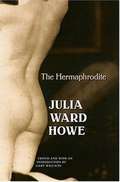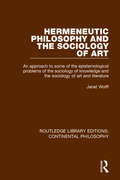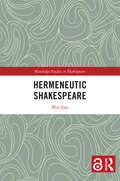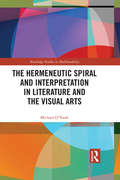- Table View
- List View
Heritage Language Program Direction: Research into Practice
by Sara M. Beaudrie Sergio LozaThis innovative text presents an introduction to different facets of building and leading language education programs at the university level to meet the needs of students who are minority speakers of a heritage language (HL) – also known as community or home languages.Providing a unique synthesis of theory and empirical research, Sara Beaudrie and Sergio Loza authoritatively illustrate and guide the reader through the main issues that program directors face from the early stage of program conceptualization and creation through later stages of program management and evaluation. The book keys in on the diverse considerations and skills involved in this leadership work – including advocacy and fund-raising, placement, curriculum development and assessment, teacher preparation and student advocacy – and offers an array of practical advice and pedagogical features.This is an invaluable resource for advanced students and scholars of applied linguistics and education, as well as future and current language program administrators in institutions of higher education, for understanding the benefits of specialized HL courses, for blazing a trail in future research in this domain, and for forging a path to solidified institutional recognition and support for HL education.
Heritage Language Teaching: Critical Language Awareness Perspectives for Research and Pedagogy
by Sergio LozaThis innovative, timely text introduces the theory, research, and classroom application of critical approaches to the teaching of minoritized heritage learners, foregrounding sociopolitical concerns in language education. Beaudrie and Loza open with a global analysis, and expert contributors connect a focus on speakers of Spanish as a heritage language in the United States to broad issues in heritage language education in other contexts – offering an overview of key concepts and theoretical issues, practical pedagogical guidance, and field-advancing suggestions for research projects. This is an invaluable resource for advanced students and scholars of applied linguistics and education, as well as language program administrators.
Heritage Languages: Extending Variationist Approaches
by Naomi NagyHeritage language speakers often feel discouraged from using their heritage language because they are told they do not speak it well. This book offsets such views by investigating heritage language variation and change across generations in eight languages spoken in Toronto. It introduces new methodology to help readers understand and apply variationist sociolinguistic approaches to quantitatively analyze spontaneous speech. This approach, based on a corpus of 400+ speakers, shows that variation and change across the grammar of heritage languages resemble the patterns in hegemonic majority languages, contrasting with the simplification/attrition patterns in experimental heritage language studies. Chapters compare patterns across generations, across languages, across ten variables in Cantonese, and between indexical and non-indexical patterns. Heritage language speakers are quoted, showing that this research increases heritage language usage and pride. Providing a tool for language revitalization, this book is essential reading for anyone interested in learning about and/or conducting research on heritage languages.
Heritage Languages and their Speakers (Cambridge Studies in Linguistics #159)
by Maria PolinskyThis book provides a pioneering introduction to heritage languages and their speakers, written by one of the founders of this new field. Using examples from a wide range of languages, it covers all the main components of grammar, including phonetics and phonology, morphology and morphosyntax, semantics and pragmatics, and shows easy familiarity with approaches ranging from formal grammar to typology, from sociolinguistics to child language acquisition and other relevant aspects of psycholinguistics. The book offers analysis of resilient and vulnerable domains in heritage languages, with a special emphasis on recurrent structural properties that occur across multiple heritage languages. It is explicit about instances where, based on our current knowledge, we are unable to reach a clear decision on a particular claim or analytical point, and therefore provides a much-needed resource for future research.
Heritage, Nostalgia and Modern British Theatre
by Benjamin PooreThe Victorians, having once been seen as 'them', the age responsible for the mistakes of the past, were transformed by the new theatrical forms of the 1960s into 'us', a metaphor for what the nation thinks (and fears) about itself. And, since the 1980s and the rise of new biographical forms in the theatre, the emphasis has shifted further, from 'we' to 'me': plays about individuals, great and small, and their struggles for personal validation. This study argues powerfully that the stage portrayal of the Victorians in recent times is a key reference point in understanding notions of Britishness, heritage and nostalgia, and the profound politicisation of national identity over the last four decades. Using many examples drawn from theatre archives, and throwing new light on works by canonical playwrights like Bond, Edgar, and Churchill, it charts the decline in class-based narratives of the British people and the move towards plays reflecting a more atomised, individuated society, preoccupied with identity and the past but no longer able to provide a convincing account of itself as a nation.
The Heritage of Soviet Oriental Studies (Routledge Contemporary Russia and Eastern Europe Series)
by Michael Kemper Stephan ConermannThis book examines the Russian/Soviet intellectual tradition of Oriental and Islamic studies, which comprised a rich body of knowledge especially on Central Asia and the Caucasus. The Soviet Oriental tradition was deeply linked to politics – probably even more than other European ‘Orientalisms’. It breaks new ground by providing Western and post-Soviet insider views especially on the features that set Soviet Oriental studies apart from what we know about its Western counterparts: for example, the involvement of scholars in state-supported anti-Islamic agitation; the early and strong integration of ‘Orientals’ into the scientific institutions; the spread of Oriental scholarship over the ‘Oriental’ republics of the USSR and its role in the Marxist reinterpretation of the histories of these areas. The authors demonstrate the declared emancipating agenda of Soviet scholarship, with its rhetoric of anti-colonialism and anti-imperialism, made Oriental studies a formidable tool for Soviet foreign policy towards the Muslim World; and just like in the West, the Iranian Revolution and the mujahidin resistance to the Soviet occupation of Afghanistan necessitated a thorough redefinition of Soviet Islamic studies in the early 1980s. Overall, the book provides a comprehensive analysis of Soviet Oriental studies, exploring different aspects of writing on Islam and Muslim history, societies, and literatures. It also shows how the legacy of Soviet Oriental studies is still alive, especially in terms of interpretative frameworks and methodology; after 1991, Soviet views on Islam have contributed significantly to nation-building in the various post-Soviet and Russian ‘Muslim’ republics.
The Heritage Series of Black Poetry, 1962–1975: A Research Compendium
by Lauri RameyIn 1962, the Heritage Series of Black Poetry, founded and edited by Paul Breman, published Robert Hayden's A Ballad of Remembrance. By 1975, the Series had published 27 volumes by some of the twentieth-century's most important and influential poets. As elaborated in Lauri Ramey's extensive scholarly introduction, this innovative volume has dual purposes: To provide primary sources that recover the history and legacy of this groundbreaking publishing venture, and to serve as a research companion for scholars working on the Series and on twentieth-century black poetry. Never-before-published primary materials include Paul Breman's memoir, retrospectives by several of the poets published in the Series, a photo-documentary of W.E.B. Du Bois's 1958 visit to The Netherlands, poems by poets represented in the Series, and scholarly essays. Also included are bibliographies of the Heritage poets and of the Heritage Press Archives at the Chicago Public Library. This reference work is an essential resource for scholars working in the fields of black poetry, transatlantic studies, and twentieth-century book history.
Heritage Speakers of Spanish and Study Abroad (Routledge Studies in Hispanic and Lusophone Linguistics)
by Rebecca PozziHeritage Speakers of Spanish and Study Abroad is an edited volume that provides emerging research on heritage speakers of Spanish in immersion contexts in theoretical, empirical, and programmatic terms. This edited collection seeks to expand our understanding of heritage speakers of Spanish by incorporating research on their linguistic, sociolinguistic, and pragmatic development during and after a sojourn abroad, by discussing the complexities of their identity formation and negotiation during immersive stays, and by highlighting programmatic innovations that could be leveraged to better serve diverse learners in study abroad contexts. This volume advances the fields of both heritage language education and research on immersion study in a variety of ways, and will be of interest to scholars of applied linguistics, sociolinguistics, second language acquisition, and educational linguistics, especially those interested in study abroad programming and Spanish for heritage speakers.
Herland (SparkNotes Literature Guide Series)
by SparkNotesHerland (SparkNotes Literature Guide) by Charlotte Perkins Gilman Making the reading experience fun! Created by Harvard students for students everywhere, SparkNotes is a new breed of study guide: smarter, better, faster.Geared to what today's students need to know, SparkNotes provides:chapter-by-chapter analysis explanations of key themes, motifs, and symbols a review quiz and essay topics Lively and accessible, these guides are perfect for late-night studying and writing papers.
Herman Melville
by Newton ArvinOne of America's most enigmatic literary figures, Herman Melville lived a life full of adventure, hardship, and moral conflict. Known for his nautical escapades, Melville first went to sea in his early twenties, sailing to England and then Polynesia where he found himself fleeing from cannibals, joining a mutiny, and frolicking with naked islanders. His novels were, for the most part, unsuccessful and misunderstood, and later in life he had to accept work as a low-level customs agent to support his wife and children. His only close friend was Nathaniel Hawthorne to whom he dedicated Moby-Dick. Newton Arvin's biography captures the troubled, often reclusive man whose major works include Typee, Omoo, Bartleby the Scrivener, Billy Budd, and his indisputable masterpiece, Moby-Dick. <P><P> Winner of the National Book Award
Herman Melville (Critical Heritage Ser.)
by Watson G. BranchThis set comprises 40 volumes covering 19th and 20th century European and American authors. These volumes will be available as a complete set, mini boxed sets (by theme) or as individual volumes. This second set complements the first 68 volume set of Critical Heritage published by Routledge in October 1995.
Herman Melville
by Elizabeth HardwickA single novel, an eternal classic, established him as a founding father of American literature. Now, a century after his death, a new popular surge of interest in Herman Melville calls for Elizabeth Hardwick's rich analysis of "the whole of Melville's works, uneven as it is, and the challenging shape of his life ... a story of the creative history of an extraordinary American genius. "Hardwick's superb critical interpretation and award-winning novelistic flair reveal a former whaleship deckhand whose voyages were the stuff of travel romances that seduced the public. Later, a self-described "thought-diver" into "the truth of the human heart," Melville harbored a bitterness that knew no bounds when that same public failed to embrace his masterwork, Moby-Dick. Invaluable for enthusiasts of American literature, Herman Melville is itself a masterpiece of critical commentary in the tradition of D. H. Lawrence's Studies in Classic American Literature.
Herman Melville: A Biography
by Leon HowardThis title is part of UC Press's Voices Revived program, which commemorates University of California Press’s mission to seek out and cultivate the brightest minds and give them voice, reach, and impact. Drawing on a backlist dating to 1893, Voices Revived makes high-quality, peer-reviewed scholarship accessible once again using print-on-demand technology. This title was originally published in 1951.
Herman Melville (Routledge Library Editions: The American Novel #10)
by D. E. MaxwellIn this fascinating and revealing book, first published in 1968, Maxwell examines the life and work of Herman Melville. By dividing extracts of Melville’s work in chronological order, the sections clearly illustrate the various facets of Melville’s technique and thought as it evolves. This title is essential reading for students of American Literature.
Herman Melville in Context (Literature in Context)
by Kevin J. Hayes"Herman Melville in Context provides the fullest introduction in one volume to the multifaceted life and times of Herman Melville, a towering figure in nineteenth-century American and world literature. The book grounds the study of Herman Melville's writings to the world that influenced their composition, publication and recognition, making it a valuable resource to scholars, teachers, students and general readers. Bringing together contributions covering a wide range of topics, the collection of essays covers the geographical, social, cultural and literary contexts of Melville's life and works, as well as its literary reception. Herman Melville in Context will enable readers to approach Melville's writings with fuller insight, and to read and understand them in a way that approximates the way they were read and understood in his time"--
Herman Wouk: The Novelist as Social Historian
by Arnold BeichmanArnold Beichman's comprehensive study of the writings of Herman Wouk, one of America's leading writers, shows how Wouk's plays and novels exemplify an extraordinary and often highly perceptive preoccupation with American society in war and in peace. Situating Wouk in the same literary tradition as Cervantes, Richardson, Balzac, and Dickens, Beichman demonstrates that Wouk's novels have strong plots, moralist outcomes, and active--essentially positive--characters. The new introduction serves to bring Wouk's work over the past two decades into the reckoning.Making extensive use of Wouk's personal papers and manuscripts as well as personal interviews with him, Beichman's focus is on the social and literary qualities of Wouk's work. In particular, he examines eight novels including War and Remembrance and The Winds of War; The Traitor, one of his three plays; and two moral tracts on Judaism. Wouk has written four more novels, including his latest, A Hole in Texas, his twelfth.Beichman portrays Wouk as one of the few living novelists concerned with virtue, and sees his work as against the mainstream of contemporary American novelists. These, he argues, have eschewed such elements of the traditional novel as invention, coincidences, surprises, suspense, and a moral perspective more presumed than examined.
Hermann Hesse: Life and Art
by Joseph Mileck"A critical biography far surpassing the previous ones."--Times Higher Education Supplement "There are to be sure many writers whose biographies are more interesting than their fiction but Hesse is not one of these. He led a long and sometimes eventful life with marital tensions, traveL controversy, crises, even some thoughts of suicide and a period of time as a student in a home for retarded and unmanageable. In addition, there was his search which led him through the culture and arts of West and East, his views of politics and society, of psychology and philosophy. The difference between Hesse and other writers is that virtually every shred and patch of his life was brought into his writing, his fiction particularly. 'He had to write about himself and there is little of what he wrote that is not confessional in form and therapeutic in function.' Autobiography is the very matter of his work. Mileck's contribution is to extend and fill out the evidence of his life, his psychoanalysis, his drive toward self-realization which was the very engine of his being, to show the raw material and thus to invite readers to see how it was transmuted, transfigured, fantasized, poeticized, symbolized."--Los Angeles Times "Hesse was a prolific author for some 60 years, and his mind drew everything it contemplated into his private wars between flesh and spirit. objectivity and subjectivity, the longings for society and isolation. No one is better qualified to disentangle this abundance than Mileck, compiler of the huge two-volume Hesse bibliography. For completeness, then, no biography in English compares." --Kirkus Reviews "Mileck provides his own translations of the German quotations from Hesse's works, and the eight interpretive chapters are thoroughly indexed, making the work readily accessible to researchers and students concerned with specific Hesse questions and themes. This very readable book also contains a number of exceptional photographs, which, together with Mileck's fervor and understanding of the author, help create a living image of Hesse the man and the artist."--Choice "Professor Mileck . .. brings to his task an acquaintanceship with Hesse's published and unpublished writings .. . which borders on omniscience. This is a literary biography which concentrates on the works and looks at the life of its subject briefly and always in relation to its involvement with the works . . . [This] is true scholarship, which does not make the book less readable and accessible to the general public. . . . a solid and valuable book which should make it easier . . . to bring [Hesse] back into the orbit of serious appreciation in the English-speaking world." --Books and Bookmen
Hermanos de sangre: Historias de la 'Ndragheta la mafia más poderosa
by Nicola GratteriLa extraordinaria reconstrucción del universo criminal de la 'Ndrangheta', la mafia más poderosa y desconocida. La 'Ndrangheta calabresa siempre ha sido infravalorada, considerada un fenómeno criminal menor, casi folclórico. Solo sale a la luz pública en momentos de sanguinaria celebridad, como ocurrió en Duisburgo (Alemania) en 2007, en un salvaje ajuste de cuentas en el que murieron seis personas. Crecida y fortalecida en el silencio, tiene hoy ramificaciones en todas las regiones italianas y en los cinco continentes y contactos con las principales organizaciones terroristas y criminales del mundo. Nicola Gratteri y Antonio Nicaso son los mayores expertos mundiales sobre esta organización criminal, cuya evolución no ha anulado los antiguos rituales, que han sido readaptados, pero nunca descartados. Una liturgia en la que conviven el arcángel san Miguel y mitos ancestrales, invocaciones improbables al Evangelio y a la religión cristiana, y pintorescos rituales de iniciación centrados en el protagonismo del «vínculo de sangre». Un universo simbólico que puede parecer extraño e incluso delirante, pero que resulta muy útil para conservar una sola identidad en cualquier lugar y ocasión. Gratteri y Nicaso han logrado una extraordinaria reconstrucción de la historia y la atmósfera de un universo criminal de asombroso alcance y brutalidad. Reseñas:«El libro que revela la sangre, el dinero y los rituales de la poderosa 'Ndrangheta, una mafia que salió de las montañas para conquistar el mundo.»Roberto Saviano «La obra máxima, la piedra angular de lo que concierne a la 'Ndrangheta y su escalada al poder mundial de las organizaciones criminales.»Benny Calasanzio Borsellino
Hermanos de tinta
by Nahum MonttEs el año de 1605, y España se prepara para ?rmarla rati?cación del tratado de paz con Inglaterra, luegode casi veinte años de guerra. Más de 500 inglesesllegan a Valladolid con motivo de las celebraciones.Con este hecho histórico como telón de fondo,Nahum Montt narra el encuentro entre dos hermanosde tinta: Miguel de Cervantes y WilliamShakespeare.Cervantes pasa di?cultades como comisario enValladolid y Shakespeare llega con la delegacióninglesa y su compañía de teatro. Uno y otro gozande cierto reconocimiento, pero el encuentro no lopropiciará la fama sino el infortunio.Una novela en donde la realidad y la ?cción tejen unrico entramado de intrigas, de aventuras y desencuentrosentre estos dos personajes, que sumergen al lectoren una atmósfera turbulenta recreada con talento.«¿Qué podía tener en común él, unaventurero español que había sido de todo enla vida: prófugo, soldado, cautivo, comisarioy autor de comedias y novelas# qué podíatener en común él con un dramaturgo inglésllamado William Shakespeare?».
The Hermaphrodite (Legacies of Nineteenth-Century American Women Writers)
by Julia Ward HoweWritten in the 1840s and published here for the first time, Julia Ward Howe's novel about a hermaphrodite is unlike anything of its time-or, in truth, of our own. Narrated by Laurence, who is raised and lives as a man and is loved by men and women alike, yet can respond to neither, this unconventional story explores the realization "that fervent hearts must borrow the disguise of art, if they would win the right to express, in any outward form, the internal fire that consumes them." Laurence describes his repudiation by his family, his involvement with an attractive widow, his subsequent wanderings and eventual attachment to a sixteen-year-old boy, his own tutelage by a Roman nobleman and his sisters, and his ultimate reunion with his early love. <p><p> His is a story unique in nineteenth-century American letters, at once a remarkable reflection of a largely hidden inner life and a richly imagined tale of coming-of-age at odds with one's culture.
Hermaphrodites in Renaissance Europe (Women and Gender in the Early Modern World)
by Kathleen P. LongKathleen Long explores the use of the hermaphrodite in early modern culture wars, both to question traditional theorizations of gender roles and to reaffirm those views. These cultural conflicts were fueled by the discovery of a new world, by the Reformation and the backlash against it, by nascent republicanism directed against dissolute kings, and by the rise of empirical science and its subsequent confrontation with the traditional university system. For the Renaissance imagination, the hermaphrodite came to symbolize these profound and intense changes that swept across Europe, literally embodying these conflicts. Focusing on early modern France, with references to Switzerland and Germany, this work traces the symbolic use of the hermaphrodite across a range of disciplines and domains - medical, alchemical, philosophical, poetic, fictional, and political - and demonstrates how these seemingly disparate realms interacted extensively with each other in this period, also across national boundaries. This widespread use and representation of the hermaphrodite established a ground on which new ideas concerning sex and gender could be elaborated by subsequent generations, and on which a wide range of thought concerning identity, racial, religious, and national as well as gender, could be deployed.
Hermeneutic Philosophy and the Sociology of Art: An Approach to Some of the Epistemological Problems of the Sociology of Knowledge and the Sociology of Art and Literature (Routledge Library Editions: Continental Philosophy #4)
by Janet WolffThis book, first published in 1975, is an examination of the theoretical foundation of the sociology of art and literature and an in-depth study in the sociology of knowledge. In discussing and clarifying some of the important philosophical issues in this field, the constant underlying reference is to the creative and artistic-expressive areas of knowledge – so that the better understanding of the social nature and genesis of all knowledge may point the way towards a similar comprehension of art and society.
Hermeneutic Shakespeare (Routledge Studies in Shakespeare)
by Min JiaoThis volume takes a deep dive into the philosophical hermeneutics of Shakespearean tradition, providing insight into the foundations, theories, and methodologies of hermeneutics in Shakespeare. Central to this research, this volume investigates fundamental questions including: what is philosophical hermeneutics, why philosophical hermeneutics, what do literary and cultural hermeneutics do, and in what ways can literary and cultural hermeneutics benefit the interpretation of Shakespearean plays? Hermeneutic Shakespeare guides the reader through two main discussions. Beginning with the understanding of "Philosophical Hermeneutics", and the general principles of literary and cultural hermeneutics, the volume includes philosophers such as Friedrich Ast, Daniel Friedrich Schleiermacher, and Wilhelm Dilthey, as well as Ludwig Wittgenstein, Martin Heidegger, Hans-Georg Gadamer, and more recently, Steven Connor. Part Two of this volume applies universal principles of philosophical hermeneutics to explicate the historical, philosophical, acquired, and applied literary interpretations through the critical practices of Shakespeare’s plays or their adaptations, including Henry V, The Merchant of Venice, Hamlet, and The Comedy of Errors. Aimed at scholars and students alike, this volume aims to contribute to contemporary understanding of Shakespeare and literature hermeneutics. Chapters 2, 5, and 6 of this book are available for free in PDF format as Open Access from the individual product page at www.routledge.com. They have been made available under a Creative Commons Attribution-Non Commercial-No Derivatives 4.0 license. Funded by Guangdong University of Foreign Studies.
The Hermeneutic Spiral and Interpretation in Literature and the Visual Arts (Routledge Studies in Multimodality)
by Michael O'TooleThis collection brings together eighteen of the author’s original papers, previously published in a variety of academic journals and edited collections over the last three decades, on the process of interpretation in literature and the visual arts in one comprehensive volume. The volume highlights the centrality of artistic texts to the study of multimodality, organized into six sections each representing a different modality or semiotic system, including literature, television, film, painting, sculpture, and architecture. A new introduction lays the foundation for the theoretically based method of analysis running through each of the chapters, one that emphasizes the interplay of textual details and larger thematic purposes to create an open-ended and continuous approach to the interpretation of artistic texts, otherwise known as the "hermeneutic spiral". Showcasing Michael O’Toole’s extensive contributions to the field of multimodality and in his research on interpretation in literature and the visual arts, this book is essential reading for students and scholars in multimodality, visual arts, art history, film studies, and comparative literature.
